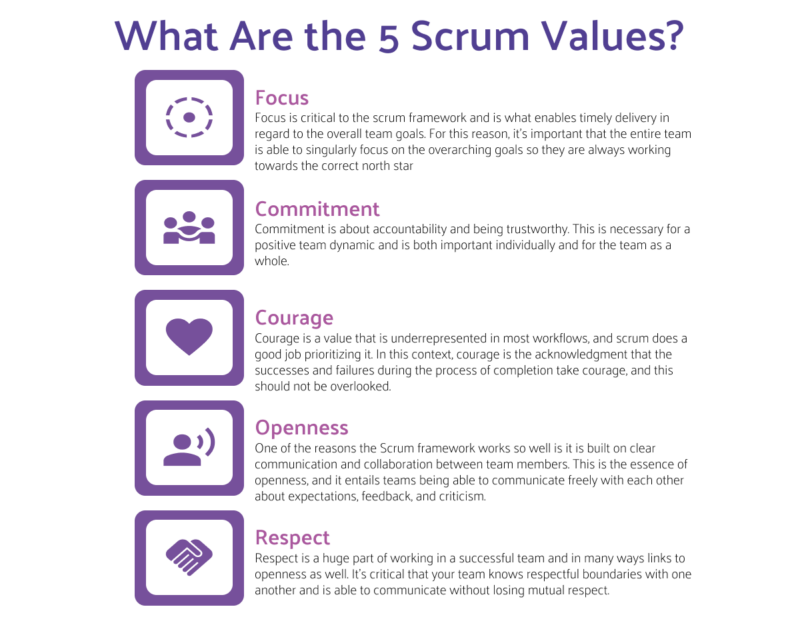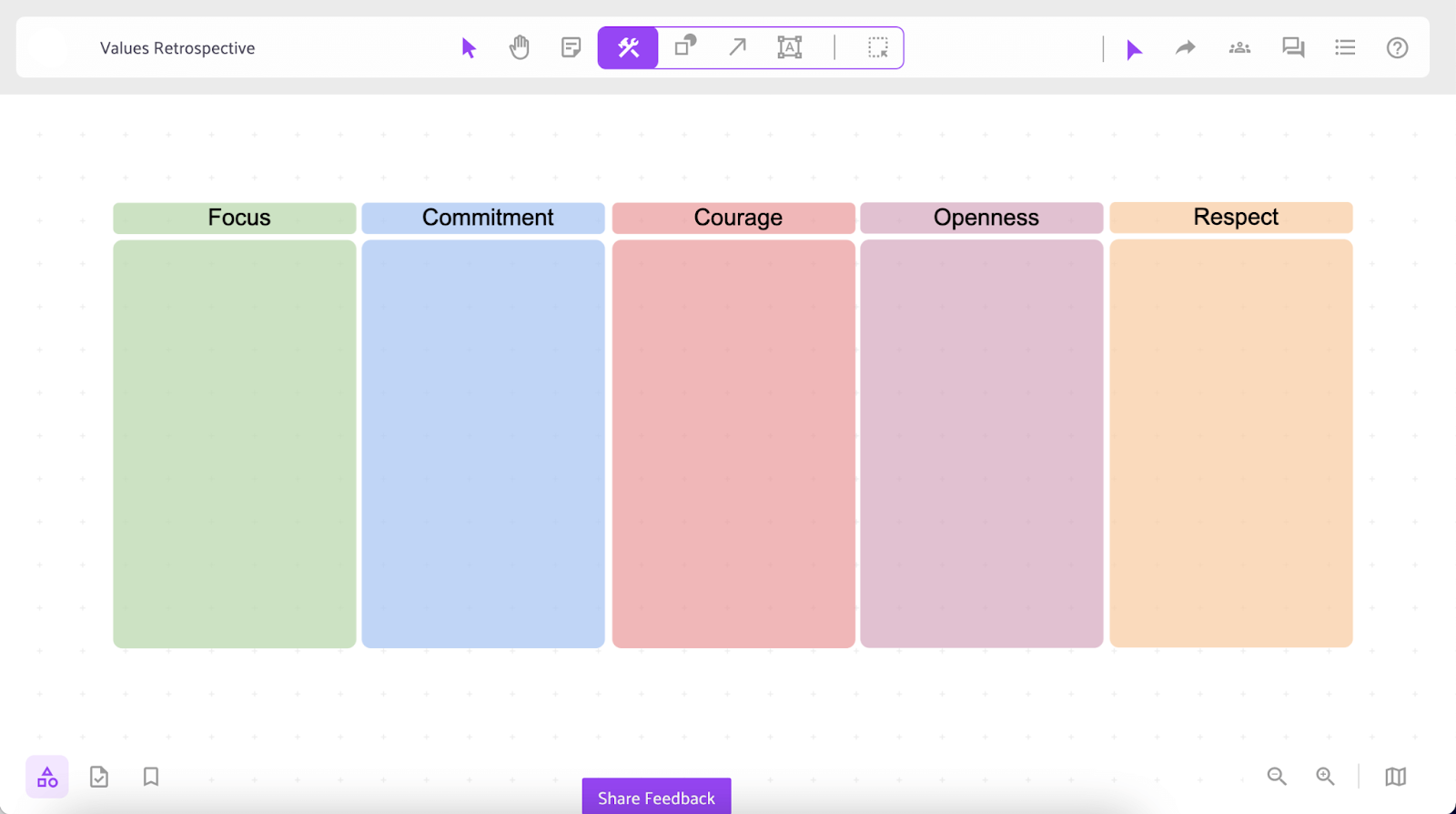Table of Contents
Creating tangible tasks isn’t the only way to improve workflows. Focusing on team values can be an incredibly impactful exercise when done correctly and can create a cohesive, strong team environment. The scrum values retrospective is a template that helps organize key team values in an effort to optimize them for the future. In this article, we will discuss the importance of a values retrospective and define how you can implement one with your team.
What is a Values Retrospective?
A values retrospective is defined as a template that walks through the important values of a scrum team and creates a set of shared expectations for the team moving forward.
This retrospective format is a mix of a traditional retrospective and a diagram of the specific values of a scrum team. Since it specifies distinct values important to the scrum framework, it’s purposefully geared toward scrum teams. It doesn’t focus as much on the tangible tasks that people accomplish during the project but more analyzes the values and expectations they have for one another.
The values retrospective is fairly unique because, unlike traditional retrospective frameworks, it focuses on attitudes and expectations rather than tangible actions. Most of the time, you will diagram the tasks and actions that your team accomplished from the previous sprint, and you will use those as a baseline to move forward. Instead of focusing on actionable tasks, the values retrospective centers around shared expectations and values.
This may seem abstract, but as you complete multiple sprints with the same team, your expectations of each other will evolve, and you will end up approaching projects differently depending on how you interact with one another. This means communicating your values and verbalizing your expectations can be an important exercise if everyone is to stay on the same page.
Additionally, this board can be paired easily with the scrum board, which allows you to diagram the flow of different tasks as they move toward completion. This is a great way to gain value from both the task side and the values side of team building.

How to Build a Values Retrospective
Because this retrospective focuses on values rather than outcomes, its structure is inherently different from more traditional retrospectives. Here’s an overview of how to build a values retrospective and how each section is unique.
There are generally 5 columns of a values retrospective, with each one corresponding to a different set of values within your team. Traditionally the five core values of scrum are:
- Focus
- Commitment
- Courage
- Openness
- Respect
Each of these values will have its own column with a prompting question, and these questions will help explain the overall goals of each section.
Focus
Focus is critical to the scrum framework and is what enables timely delivery in regard to the overall team goals. For this reason, it’s important that the entire team is able to singularly focus on the overarching goals, so they are always working towards the correct north star. When analyzing focus, consider what needs to be done to improve your shared focus and whether you need to improve the process or the goals in order to get there.
In this column, it’s important to ask questions like:
- How can we, as individuals and as a team, create a clearer focus toward our goals?
- How can we effectively overcome distractions?
Commitment
Commitment is about accountability and trust. This is necessary for a positive team dynamic and is both important individually and for the team as a whole. Commitment is especially important in scrum because there is heightened importance on timely accomplishment, and this leaves little room for error. People need to show commitment to themselves, their goals, and the team’s expectations, among other things. If there is a lack of commitment, your team could have a significant issue to tackle.
In this column, it’s important to ask questions like:
- How will our commitments allow us to achieve our goals?
- How can we improve our commitment individually?
- What can we do to improve as a collective?
Courage
Courage is a value that is underrepresented in most workflows, and scrum does a good job of prioritizing it. In this context, courage is the acknowledgment that the successes and failures during the process of completion take courage, and this should not be overlooked. It is an admittance that your team must be courageous in order to reach their goals, and not all things will come easily.
In this column, it’s important to ask questions like:
- How will we respond to roadblocks?
- How will we complete difficult tasks and problems?
Openness
One of the reasons the Scrum framework works so well is it is built on clear communication and collaboration between team members. This is the essence of openness, which entails teams being able to communicate freely with each other about expectations, feedback, and criticism. Because it’s focused on feedback and improved communication, openness is a great value to target if you feel your team is not engaged in continuous improvement of themselves and their processes.
Creating openness is not possible if there is judgment involved, so it’s important that in this section, your team creates clear expectations around how they will communicate healthily.
In this column, it’s important to ask questions like:
- How can we be open to new possibilities?
- How can we approach sensitive topics in a neutral way?
Respect
Respect is a huge part of working in a successful team and, in many ways, links to openness as well. It’s critical that your team knows respectful boundaries with one another and is able to communicate without losing mutual respect. In many ways, having an environment built on mutual respect is a great way to drive efficiency and confidence within your team as well.
In this column, it’s important to ask questions like:
- How can we demonstrate our respect for each other?
- What are some respectful ways for us to communicate?
Learn more: What is a Lean Canvas?
Why Is a Values Retrospective Important?
Now that we have a solid grasp on the structure of the values retrospective, let’s briefly discuss why it’s important to conduct a retrospective in general and what special traits the values retrospective brings to the table.
- Helps improve future projects: As we discussed in our guide about retrospectives, regardless of the specific template, retrospectives always “target the optimization of future projects through the lens of past successes and failures.” The values retrospective is no different; it just seeks to improve projects through shared values instead of task optimization. Both of these angles are important for a successful team, and when working with the same crew repeatedly, focusing on values and expectations can be the key to improving future projects.
- Creates team cohesion: Sometimes, teams experience friction because there isn’t enough communication. The values retrospective enables people to properly communicate what’s important to them, ensuring there is no confusion or misalignment within the team. This can create a deeper understanding between peers and cohesion for an entire team.
- Prioritizes employee experience: It can be argued that creating an understanding around courage, communication, expectations, and respect is just as important as highlighting the tasks that will arise during your next project. This is because, without clear communication and expectations, people can develop a negative experience working with a team that doesn’t seem to prioritize their values. Conducting a values retrospective can help alleviate these issues and can vastly improve the experience of individual team members.
The values retrospective isn’t just about preparing for your next project, it’s about creating a team dynamic that can accomplish any project. This understanding of teamwork and communication provides so much importance to the values retrospective and is the key factor that sets it apart from other retrospective templates.
When to Run a Scrum Values Retrospective
Running a scrum values retrospective is helpful for any sprint format. When used generally, however, it can be hard to differentiate how it provides unique value outside of a traditional retrospective template.
Conducting a values retrospective is most beneficial when alleviating some friction within a team or evaluating why a set of goals was missed. It’s uniquely helpful in these scenarios because by focusing on individual and team values, you can often find key misalignment between team members that’s causing inefficiency, miscommunication, and roadblocks.
Using a visual collaboration tool like IdeaScale Whiteboard makes communicating these various needs easy and clear, increasing the efficacy of a values retrospective even further.
How Scrum Values Create a Strong Team
Having core values is important for any team. It helps create identity, commitment, and ownership. Especially for a scrum team, strong values can be the difference between completing a project on time and missing a deadline. Focus, commitment, courage, openness, and respect are crucial values, but how do they work to build a strong and successful team?
The key to implementing scrum values is communication. Communicating values in a retrospective is a great way to formalize them, but it’s even more important to communicate them during a project cycle. Values need to be seen and felt to have a real impact, and when they’re practiced regularly, you will begin to see the benefits of this exercise.
One of the most important ways to communicate scrum values is to lead by example. People will look to team leadership for behavioral guidance throughout a project, and you need to demonstrate your desired values, so people have a good example to reference. Here are some of the ways you can express your values to create a strong team:
- Courage: Take on difficult tasks and don’t hide failure.
- Focus: Always prioritize the schedule, and stick to it.
- Commitment: Commit to your work and bring your best every day.
- Respect: Demonstrate trust and respect for your team members through independence.
- Openness: Communicate frequently about both the good and the bad.
On top of this, you need to provide your team with an effective platform to communicate and work through. An online whiteboard can be the perfect tool, and using it can help people infuse these values into their workflow. By using templates like Kanban, Scrum Board, and other project management structures, online whiteboards can help facilitate strong team values.
Learn more: Kanban vs Waterfall vs Scrum vs Lean
Five Simple Steps to Conduct a Team Retrospective in IdeaScale Whiteboard
Creating a values retrospective within IdeaScale Whiteboard is easy, and it just takes a couple of simple steps to get your team to collaborate. Here is how you can leverage IdeaScale Whiteboard to create, conduct, and act on a values retrospective.
- Create a template: The first step is creating your template. You can select an existing retrospective and edit it to meet your needs, or you can easily create one from scratch to make it specifically suited to your team.
- Invite your team: After creating your board, invite your team so everyone can use the template collaboratively. The values retrospective is an activity that needs to be done in real time, so invite your entire team so everyone can get involved.
- Begin collaborating: Once you’re ready, begin collaborating with your team to watch the board fill up. Make sure that you (or someone else) moderates the session so everyone gets a chance to share and the board is fully completed at the end.
- Create action items: Once the board is filled up, you need to prioritize some action items to ensure your important takeaways get acted on. With our internal task management tool, you can create & manage tasks within the same workflow, so you never have to worry about losing your progress again.
- Watch your plan come to life: After the tasks are created, and the retrospective is done, take your action items into the next project and watch them come to life!
Conclusion
When you focus on team values in an effort to improve future projects, there’s no limit to where your team can reach. If you liked this guide, stay tuned to IdeaScale Whiteboard to learn about more useful collaboration templates to help optimize your workflow.
Most Recent Posts
Explore the latest innovation insights and trends with our recent blog posts.













